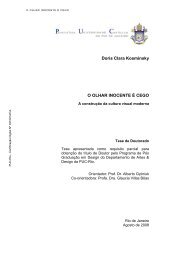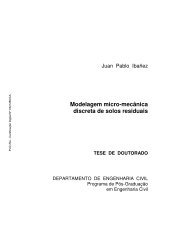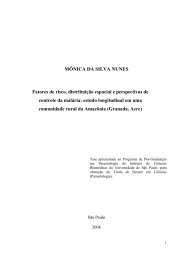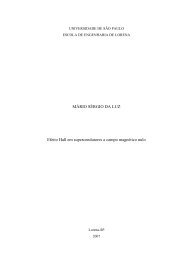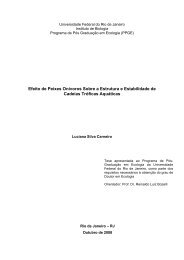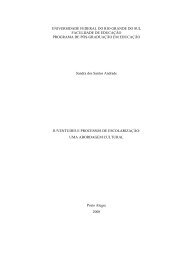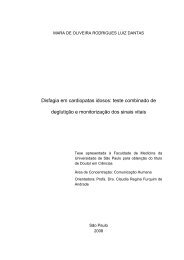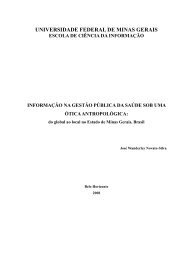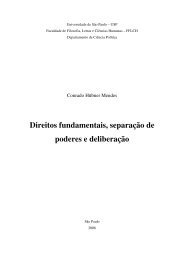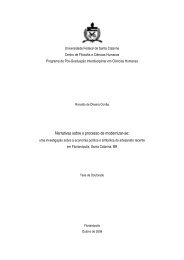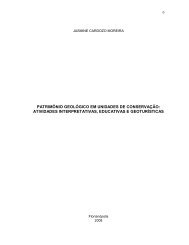You also want an ePaper? Increase the reach of your titles
YUMPU automatically turns print PDFs into web optimized ePapers that Google loves.
R.S. Car<strong>do</strong>so et al. / Molecular Immunology 43 (2006) 464–472 465the TR <strong>gene</strong> rearrangements begin, several <strong>gene</strong>s related toDNA synthesis, protein metabolism, onco<strong>gene</strong>s, transcriptionfactors and signal transduction are modulated in concert(Espanhol et al., 2004; Magalhães et al., 2005).Functional analysis of T-cell development has becomepossible after the introduction of techniques in which thethymic microenvironment is mimicked, such as fetal thymusorgan culture (FTOC). This method is based on the use ofearly fetal thymus tissue, which is composed of homo<strong>gene</strong>ousthymocyte population (<strong>do</strong>uble-negative cells), and onthe possibility of testing the induction of alterations in <strong>gene</strong>expression during T-cell development caused by chemicaland physical agents (DeLuca et al., 1995).In the present study, we demonstrated the occurrence ofthe TRBV8.1-BD2.1 rearrangement in FTOCs, indicating theoccurrence of T-cell maturation in vitro. Moreover, the FTOCtranscriptome profiling was accessed using a set of six nyloncDNA microarrays containing a total of 9216 thymus IMAGEsequences.Comparing time of thymus gestation as a result of ageof fetuses and length of cultures, versus gamma-irradiatedand unirradiated cultures, it was possible to found <strong>gene</strong>s differentiallyexpressed, several among them were consideredto be novel candidates participating simultaneously in thecontrol of T-cell receptor V(D)J recombination and DNArepair.Each phase of thymus development in FTOCs exhibiteda characteristic <strong>gene</strong> expression pattern involving <strong>gene</strong>s ofknown functions, permitting the identification of those implicatedin T-cell maturation, including the V(D)J recombinationprocess.Since in the both processes, DNA repair of damage causedby ionizing radiation and T-cell receptor V(D)J recombinationoccurs reparation of DNA <strong>do</strong>uble-strand breaks (DSBs)(Prise et al., 2001; Toki et al., 2003), we irradiated FTOCswith gamma rays to evaluate the effects on TRB V(D)J recombinationand on modulation of <strong>gene</strong>s implicated in thesemechanisms.Among the <strong>gene</strong>s which were found to be differentiallyexpressed, several were considered to be novel candidatesparticipating simultaneously in the control of T-cell receptorV(D)J recombination and DNA repair.2. Material and methods2.1. Fetal thymus organ culture, total RNA and genomicDNA preparationsBALB-c mice were bred in an 0.45 m pore size air filteredisolator in our own breeding facility. To obtain timedpregnancies, mice were mated and the day when the vaginalplug was obtained at 7:00 am was considered to be day zeroof gestation post coitum (pc). Pregnant mice were sacrificedby ether inhalation and the fetuses collected by surgery of theuterus. The pc age of fetuses was confirmed by the morphologicalcharacteristics of each developmental phase (Rugh,1968).Thymi were removed from the fetuses under a stereomicroscopeand cultured according to the organ culture techniquedescribed by DeLuca et al., (1995). The organs weredissected and cleaned from adjacent tissue and placed on thesurface of Millipore filters (0.45 m pore size) pre-embeddedwith culture medium. These filters were supported on plasticgrids in 2 ml Dulbecco’s modified Eagle’s Medium/HAMF-10 culture medium (GIBCO, USA) supplemented with20% heat inactivated fetal bovine serum (Biobrás, Brazil).The medium was also supplemented with 100 g/ml streptomycin,250 U/ml penicillin, 10 g/ml gentamicin, 1 mMsodium pyruvate, 20 M 2-mercaptoethanol and 3.4 g/Lsodium bicarbonate. The incubation time of the organ culturevaried from 2 to 5 days at 37 ◦ Cina5%CO 2 incubator.Thymi were dissected from fetuses obtained at 13, 14 and15 days of gestation and cultured for two days, respectively,mimicking 15, 16 and 17 days of in vivo development. Thymifrom 15 days pc fetuses were also cultured for 5 days, mimickingthe 20th day of in vivo development, and in this case,the culture medium was changed on the 3rd day of incubation.Immediately after culture preparation, some FTOCs wereirradiated with 4 Gy of gamma rays from 60 Co source using aGammatron S-80 apparatus (Siemens, Germany) at the <strong>do</strong>seof 0.53 Gy/min. Control cultures were sham irradiated.In order to evaluate the viability of FTOCs before and afterirradiation, three ran<strong>do</strong>mly selected thymus of each groupwas used for the single cell suspensions preparation whichwere separately stained with acridine orange (100 g/ml) orwith ethidium bromide (100 g/ml) and analyzed on a AxiophotII fluorescence microscope (Carl Zeiss, Germany) inorder to evaluate the frequency of apoptosis and necrosis,respectively.Total RNA and genomic DNA were prepared from FTOCsusing Trizol ® reagent according to manufacturer instructions(Invitrogen, USA).2.2. Semiquantitative TRBV8.1-BD2.1 recombinationassayT-cell maturation was monitored by detection of rearrangementsbetween segments TRBV8.1 and BD2.1 duringFTOC development using PCR as previously described(Muegge et al., 1993). The oligonucleotide primers werethe BV8.1 forward primer (primer 1, CAGGCTGCAGT-CACCCAAAGTCCAA), the BV8.1 reverse primer (primer2, ACAGAAATATACAGCTGTCTGAGAA) and the BJ2.1reverse primer (primer 3, TGAGTCGTGTTCCTGGTCC-GAAGAA). The PCR mixture contained 35 mM Tris, pH8.3, 50 mM KCl, 2.5 mM MgCl 2 , 100 g/ml bovine serumalbumin, nucleotide triphosphates (NTPs) (2 M each), theprimers (0.5 M each) and 1 U Taq polymerase (AmershamBiosciences, Buckinghamshire, UK), with a constant amountof genomic DNA (1 g) from each developmental stage inFTOC. The PCR program consisted of 30 cycles (1 min at



